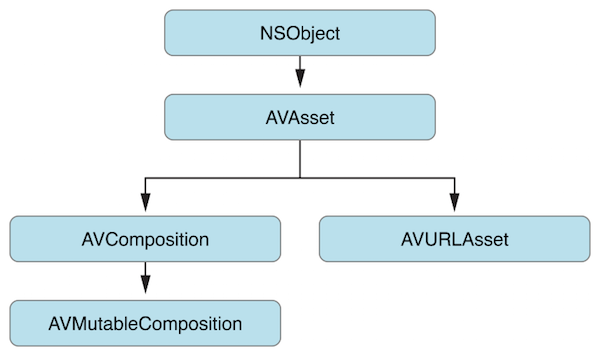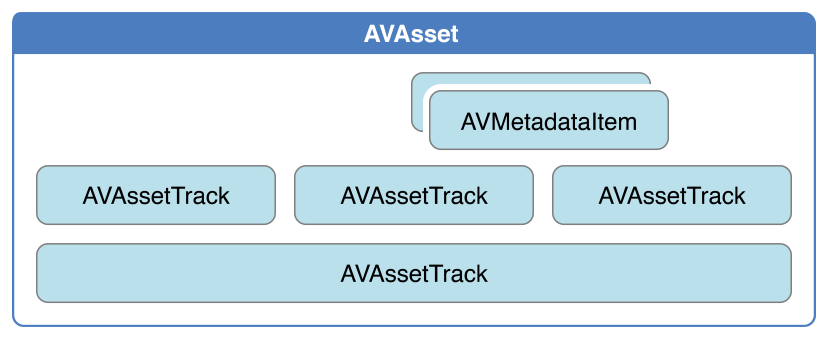AVAudioFoundation(6):时间和媒体表示
2017-05-13
本文主要内容来自 AVFoundation Programming Guide。
基于时间的音视频数据,例如电影文件或视频流,在 AVFoundation 框架中用 AVAsset 来表示。AV Foundation 用于表示时间和媒体的几个底层数据结构,来自 Core Media 框架。
资源的表示方式
AVAsset 是 AVFoundation 框架中的核心类。它对基于时间的音视频数据的进行了抽象,例如电影文件或视频流。主要关系如下图所示。在许多情况下,我们需要使用其子类之一。

Asset 包含了将在一起显示或处理的多个轨道,每个轨道均包含(但不限于)音频、视频、文本、可隐藏字幕和字幕。 Asset 提供了关于资源的完整信息,比如时长、标题,以及渲染时的提示、视频源尺寸等等。 资产还可以包含由 AVMetadataItem 表示的元数据。
轨道用 AVAssetTrack 的实例表示,如下图所示。在典型的简单情况下,一个轨道表示音频分量,另一个表示视频分量; 在复杂的组合中,音频和视频可能有多个重叠的轨道。

轨道具有许多属性,例如其类型(视频或音频),视频和/或音频特征,元数据和时间轴。轨道有一个数组用来描述其格式。该数组包含一组 CMFormatDescription 对象,每个对象描述轨道对应的媒体样本的格式。包含统一媒体的轨道(比如,都使用相同的设置来编码)将提供一个计数为 1 的数组。
轨道本身可以被划分成多段,由 AVAssetTrackSegment 的实例表示。段是从源到资产轨道时间轴的时间映射。
时间的表示
AVFoundation 中用来表示时间的数据结构主要来自于 Core Media 框架。
用 CMTime 表示时长
CMTime 是一个 C 的数据结构,它表示时间为有理数,包含分子和分母。分子表示时间值,分母表示时间刻度,分子除以分母则表示时间,单位为秒。比如当时间刻度是 10,则表示每个单位的时间值表示 1/10 秒。最常用的时间刻度是 600,因为在场景的场景中,我们用 24 fps 的电影,30 fps 的 NTSC,25 fps 的 PAL。使用 600 的时间刻度,可以准确地表示这些系统中的任何数量的帧。
除了简单的时间值之外,CMTime 结构可以表示非数值的值:正无穷大,负无穷大和无定义。 它也可以指示时间是否在某一点被舍入,并且它能保持一个纪元数字。
使用 CMTime
下面是一些使用 CMTime 示例:
CMTime time1 = CMTimeMake(200, 2); // 200 half-seconds
CMTime time2 = CMTimeMake(400, 4); // 400 quarter-seconds
// time1 and time2 both represent 100 seconds, but using different timescales.
if (CMTimeCompare(time1, time2) == 0) {
NSLog(@"time1 and time2 are the same");
}
Float64 float64Seconds = 200.0 / 3;
CMTime time3 = CMTimeMakeWithSeconds(float64Seconds , 3); // 66.66... third-seconds
time3 = CMTimeMultiply(time3, 3);
// time3 now represents 200 seconds; next subtract time1 (100 seconds).
time3 = CMTimeSubtract(time3, time1);
CMTimeShow(time3);
if (CMTIME_COMPARE_INLINE(time2, ==, time3)) {
NSLog(@"time2 and time3 are the same");
}
CMTime 的特殊值
Core Media 提供了一些关于 CMTime 的特殊值,比如:kCMTimeZero,kCMTimeInvalid,kCMTimePositiveInfinity,kCMTimeNegativeInfinity。要检查一个表示非数值的 CMTime 是否是合法的,可以用 CMTIME_IS_INVALID,CMTIME_IS_POSITIVE_INFINITY,CMTIME_IS_INDEFINITE 这些宏。
CMTime myTime = <#Get a CMTime#>;
if (CMTIME_IS_INVALID(myTime)) {
// Perhaps treat this as an error; display a suitable alert to the user.
}
不要去拿一个 CMTime 和 kCMTimeInvalid 做比较。
用对象的方式使用 CMTime
如果要使用 Core Foundation 中的一些容器来存储 CMTime,我们需要进行 CMTime 和 CFDictionary 之间的转换。这时我们需要用到 CMTimeCopyAsDictionary 和 CMTimeMakeFromDictionary 这些方法。我们还能用 CMTimeCopyDescription 来输出描述 CMTime 的字符串。
纪元
通常 CMTime 中的 epoch 设置为 0,不过我们也可以设置它为其他值来区分不相关的时间轴。比如,我们可以在循环遍历中递增 epoch 的值,每一个 0 到 N 的循序递增一下 epoch 来区分不同的轮回。
用 CMTimeRange 来表示时间范围
CMTimeRange 表示的时间范围包含两个字段:开始时间(start)和时长(duration),这两个字段都是 CMTime 类型。需要注意的是一个 CMTimeRange 不含开始时间加上时长算出来的那个时间点,即 [start, start + duration)。
我们可以用 CMTimeRangeMake 和 CMTimeRangeFromTimeToTime 来创建 CMTimeRange。但是这里有一些限制:
CMTimeRange不能跨越不同的纪元。CMTime中的epoch字段可能不为 0,但是我们只能对start字段具有相同epoch的CMTimeRange执行相关操作(比如CMTimeRangeGetUnion)。- 表示
duration的CMTime结构中的epoch应始终为 0,value必须为非负数。
使用 CMTimeRange
Core Media 提供了一系列操作 CMTimeRange 的方法,比如 CMTimeRangeContainsTime、CMTimeRangeEqual、CMTimeRangeContainsTimeRange、CMTimeRangeGetUnion.
下面的代码返回值永远为 false:
CMTimeRangeContainsTime(range, CMTimeRangeGetEnd(range))
CMTimeRange 的特殊值
Core Media 提供了 kCMTimeRangeZero 和 kCMTimeRangeInvalid 表示零长度 range 和错误 range。在很多情况下,CMTimeRange 结构可能无效,或者是零或不定式(如果其中一个 CMTime 字段是不确定的)。如果要测试 CMTimeRange 结构是否有效、零或不确定,可以使用一个适当的宏:CMTIMERANGE_IS_VALID,CMTIMERANGE_IS_INVALID,CMTIMERANGE_IS_EMPTY 或 CMTIMERANGE_IS_EMPTY。
CMTimeRange myTimeRange = <#Get a CMTimeRange#>;
if (CMTIMERANGE_IS_EMPTY(myTimeRange)) {
// The time range is zero.
}
不要拿任何 CMTimeRange 和 kCMTimeRangeInvalid 做比较。
用对象的方式使用 CMTimeRange
如果要在 Core Foundation 提供的容器中使用 CMTimeRange 结构,则可以分别使用 CMTimeRangeCopyAsDictionary 和 CMTimeRangeMakeFromDictionary 将 CMTimeRange 结构转换为 CFDictionary 类型。 还可以使用 CMTimeRangeCopyDescription 函数获取 CMTimeRange 结构的字符串表示形式。
媒体的表示
视频数据及其关联的元数据在 AVFoundation 中由 Core Media 框架中的对象表示。 Core Media 使用 CMSampleBuffer 表示视频数据。CMSampleBuffer 是一种 Core Foundation 风格的类型。CMSampleBuffer 的一个实例在对应的 Core Video pixel buffer 中包含了视频帧的数据(参见 CVPixelBufferRef)。 我们可以使用 CMSampleBufferGetImageBuffer 从样本缓冲区访问 pixel buffer:
CVPixelBufferRef pixelBuffer = CMSampleBufferGetImageBuffer(<#A CMSampleBuffer#>);
从 pixel buffer 中,我们可以访问实际的视频数据。
除了视频数据之外,您还可以检索视频帧的其他方面的数据:
- 时间信息。我们可以分别使用
CMSampleBufferGetPresentationTimeStamp和CMSampleBufferGetDecodeTimeStamp获得原始演示时间和解码时间的准确时间戳。 - 格式信息。格式信息封装在
CMFormatDescription对象中。从格式描述中,可以分别使用CMVideoFormatDescriptionGetCodecType和CMVideoFormatDescriptionGetDimensions获取像素类型和视频尺寸。 - 元数据。元数据作为附件存储在字典中。您使用
CMGetAttachment检索字典。如下面代码所示:
CMSampleBufferRef sampleBuffer = <#Get a sample buffer#>;
CFDictionaryRef metadataDictionary = CMGetAttachment(sampleBuffer, CFSTR("MetadataDictionary", NULL);
if (metadataDictionary) {
// Do something with the metadata.
}
将 CMSampleBuffer 转换为 UIImage
以下代码显示如何将 CMSampleBuffer 转换为 UIImage 对象。 使用前,我们要仔细考虑对应的需求。 执行转换是比较昂贵的操作。例如,从每隔一秒钟拍摄的视频数据帧创建静止图像是合适的,但不应该使用它来实时操纵来自录制设备的每一帧视频。
// Create a UIImage from sample buffer data.
- (UIImage *)imageFromSampleBuffer:(CMSampleBufferRef)sampleBuffer {
// Get a CMSampleBuffer's Core Video image buffer for the media data
CVImageBufferRef imageBuffer = CMSampleBufferGetImageBuffer(sampleBuffer);
// Lock the base address of the pixel buffer
CVPixelBufferLockBaseAddress(imageBuffer, 0);
// Get the number of bytes per row for the pixel buffer
void *baseAddress = CVPixelBufferGetBaseAddress(imageBuffer);
// Get the number of bytes per row for the pixel buffer
size_t bytesPerRow = CVPixelBufferGetBytesPerRow(imageBuffer);
// Get the pixel buffer width and height
size_t width = CVPixelBufferGetWidth(imageBuffer);
size_t height = CVPixelBufferGetHeight(imageBuffer);
// Create a device-dependent RGB color space
CGColorSpaceRef colorSpace = CGColorSpaceCreateDeviceRGB();
// Create a bitmap graphics context with the sample buffer data
CGContextRef context = CGBitmapContextCreate(baseAddress, width, height, 8,
bytesPerRow, colorSpace, kCGBitmapByteOrder32Little | kCGImageAlphaPremultipliedFirst);
// Create a Quartz image from the pixel data in the bitmap graphics context
CGImageRef quartzImage = CGBitmapContextCreateImage(context);
// Unlock the pixel buffer
CVPixelBufferUnlockBaseAddress(imageBuffer,0);
// Free up the context and color space
CGContextRelease(context);
CGColorSpaceRelease(colorSpace);
// Create an image object from the Quartz image
UIImage *image = [UIImage imageWithCGImage:quartzImage];
// Release the Quartz image
CGImageRelease(quartzImage);
return (image);
}
